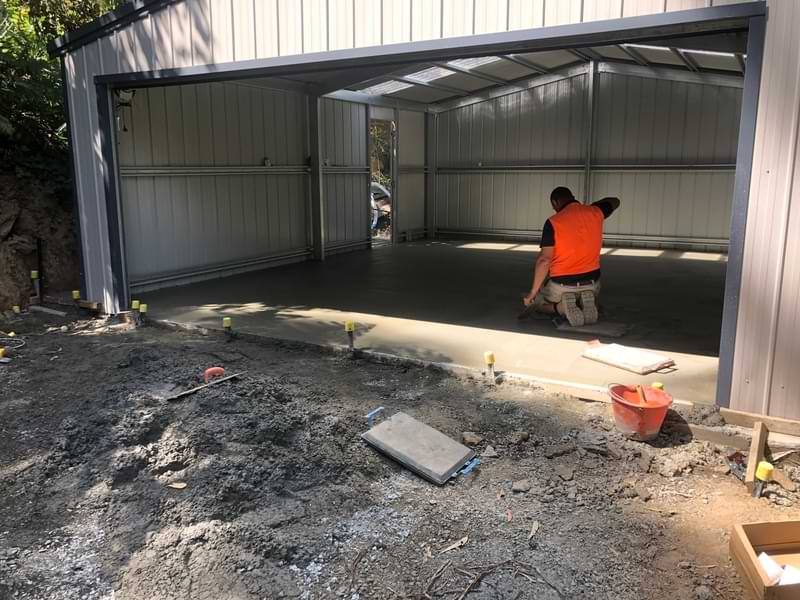As the parable says, it’s a wiseman that builds their home on rock and a fool that builds theirs on sand. But how do you know you haven’t hired a fool and, more importantly, how do you know they aren’t making a fool of you? At JMC Concrete we’re dedicated professionals offering an honest, reliable, and affordable service. With over a decade of experience in construction, and eight years alone specialising in concrete, we’ve learned a thing or two about how concrete should be laid. So JMC Concrete is laying out the ten signs you should watch out for when you use a concrete contractor.
1. They’re Not Using Reinforcements
Reinforcements are a must with concrete. Concrete has great comprehensive strength but needs a little help to get similarly strong tensile strength. Reinforced concrete can withstand tremendous pressure but if it isn’t reinforced, cracks may appear. Beyond the aesthetic issues, cracks can allow harmful materials to enter the concrete causing more cracks and further damage. Therefore, your contractor should reinforce the concrete with steel, whether it’s rebar rods, welded wire reinforcing fabric or trench mesh.
2. They’re Not Spacing the Reinforcements Properly
However, having reinforcements isn’t nearly as effective as it could be if they’re not properly laid. To ensure proper and complete reinforcement, you should see your contractor overlaying the reinforcements at least 500mm — about the length of two bricks. If your concrete has a junction or turn, like a T or an L shape, your contractor should be using more overlaps in these areas. If the reinforcements aren’t properly placed, the concrete won’t last as long as it should, and it’ll end up costing you more.
3. They’ve Placed the Reinforcements on the Ground
Make sure your contractor isn’t putting the reinforcements flat on the ground. If the reinforcements are lying on the ground, they can rust and may disintegrate. Your contractor should support the reinforcements with wire, concrete or plastic bar chairs. These bar chairs should be spaced no more than 800mm apart, roughly a stride or step, to ensure maximum reinforcement.
4. They Haven’t Cleaned the Reinforcements
Before any reinforcements are laid, your contractor should clean them. Loose rust, mud, paint, or oil will affect the concrete’s bond with the reinforcements, weakening the tensile strength. This can lead to cracks. Some rust can be good as it makes the steel surface rougher, like providing the concrete little handholds. However, if you rub a cloth over the steel and rust comes off then, once again, it will weaken the bond.
5. Their Mixture Isn’t Smooth
As the concrete is being poured, your contractor should ensure that the mixture is fairly smooth — without large lumps or chunks. There shouldn’t be bits (or aggregates) bigger than 20mm — about the size of your fingernail. If your contractor has bigger sized aggregates in their mixture, there’ll be less water in the mixture meaning the cement won’t bond as well. This makes it more likely your concrete driveway will crack.
6. They Haven’t Done a Slump Test
You should see your contractor do a slump test. A slump test is like a baker testing the mixture of a cake. It measures the workability, or consistency, of freshly mixed concrete. They’ll insert a rod into the wet concrete and pull the rod back out. You can expect some of the concrete to pull back with the rod, but not too much. If a lot of concrete comes away with the rod, there’s an issue with the slump. It may mean they’ve added too much water, which can create voids in the concrete and weaken it. If the mixture is too dry then the concrete will dry unevenly, leading to cracks.
7. They’re Taking Too Long
Once water is added to the mix, your contractor should have it all out of the mixer in ninety minutes. If they take longer, the concrete may not set correctly. However, they may have added a special chemical to allow them more time, but make sure you ask them about it.
8. They Aren’t Vibrating the Concrete
When your contractor pours the concrete, it will contain air pockets. Your contractor must vibrate these air pockets out. These air pockets will greatly weaken the concrete, making it susceptible to termites and salt damp.
However, your contractor must be careful to not over-vibrate the concrete either as this can cause problems like honeycombing. You may want to ask your contractor how they know when the concrete has been sufficiently vibrated.
9. They Aren’t Curing the Concrete
Your contractor should cure the concrete after it’s been poured. Curing is controlling the rate of moisture loss from the concrete by constantly wetting the surface. If the concrete dries unevenly it can weaken, and large chunks can separate (a process called spalding). Make sure the contractor is curing the edges of your slab too. This will improve their resistance to edge dampness.
Some contractors may use chemicals to cure concrete. If you’re intending to cover the concrete with, for example, tiles, you should check in with your contractor before they start work. They may need to alter their process to ensure there’s no problems with shrinking and cracking.
10. They’re Offering Repairs
Repairs and restoration can seem like a good idea, but as JMC Concrete knows from years of experience, it’s likely to lead to structural problems with more cracks than when you started. We always remove and replace the affected concrete as it’s the smarter, more effective and more prudent decision — any good contractor will tell you that.
Get the Benefit of Experience
Laying concrete can be a hassle without the right technical knowledge. We at JMC Concrete take that worry away through reliable, affordable and top-quality workmanship. So, if you want to know you’re getting perfect concrete every time, get in touch with JMC Concrete today.
